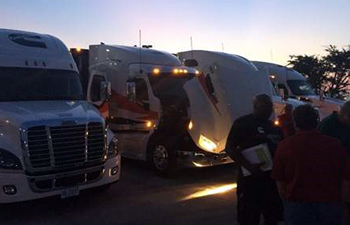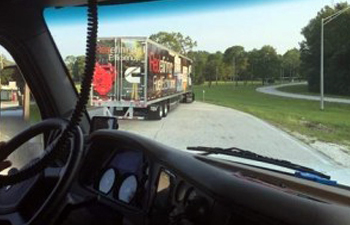Cummins Tour – Crossing the Florida-Georgia Line
By Cummins Inc., Global Power Technology Leader

This is it! My first time riding in a truck outside of a small test track on the west side of Columbus, Indiana. After standing for eight hours in 90-degree, 90% humidity heat, riding in a truck with air conditioning for eight hours seemed like a vacation. Except in order to make it to Atlanta on time, the trip started out at six o'clock in the morning.

I had the pleasure of riding in the Peterbilt 579, which was powered by our performance oriented 2017 ISX15. With the relative flatness of the terrain between Orlando and the Florida/Georgia state line, the Peterbilt easily stayed in top gear.
One of the differences I noticed between Indiana (where I’m from) and Florida was the speed limit the trucks were allowed to go. In Indiana, the trucks are held to a 65 mph speed limit, whereas in Florida, the speed limit is 70 MPH for all vehicles. Even though 5 mph doesn’t seem like a lot, when a truck is traveling faster than 55 mph, aerodynamic drag has the greatest impact of fuel economy. A good rule of thumb is that for every 1 mph the vehicle increases, the fuel economy is reduced by 0.1 mpg; therefore, this 5 mph difference can result in a loss of 0.5 mpg.

After getting separated from the group due to the random weight station requests, the trucks met back up at the rest stops and diesel fueling stations. After refueling, I took the opportunity to ride in the International ProStar + which is equipped with the 2017 ISX15 Maximum Efficiency engine. I was really looking forward to seeing the electronic features settings of the SmartAdvantage Powertrain and ADEPT in action.
With a background in supporting PowerSpec, and having a good grasp at the theory of the electronic features, seeing and feeling them at work was interesting. The first “aha” moment for me was when the ProStar + accelerated at a slightly slower, but steady pace after exiting a weight station. At first I was confused why it felt slower to accelerate than I expected, but then I realized that I was experiencing the Vehicle Acceleration Management feature in action! Vehicle Acceleration Management, or VAM, allows a vehicle that is not fully loaded to accelerate at the same rate as a fully loaded vehicle. This prevents excessive tire and driveline wear when getting up to speed, and provides a smoother, more efficient transition from slow to targeted road speeds.
Another amazing feature to experience was SmartCoast. During the rolling hills leading into Atlanta, the SmartCoast feature was really noticeable. During downhill events, the tachometer dropped to approximately 600 rpm, and the engine vehicle got really quiet. The first time I experienced SmartCoast in action, the quietness of the vehicle was eerie. You could almost carry a conversation with a passenger at a whisper level and be able to hear each other perfectly.
When the vehicle needed additional power (e.g. next uphill event, or to maintain the desired cruise speed), the transmission would reengage and the tachometer would jump back to the 1150-1200 rpm range. If Mike (the driver) needed to brake, the transmission would reengage, the tachometer would move to higher rpms, and the engine brakes would engage. Overall, the ISX15 in the ProStar + was smooth, efficient, and made for a comfortable, quiet ride.
After experiencing the thrilling rolling hills as we approached the south side of Atlanta, we arrived to the Tour Site, and proceeded to setup for the events. The Atlanta events had great turnouts, and the weather was about as perfect as could be.
Written by: E. McCoy – Cummins Marketing Specialist
Author Profiles

Cummins Inc., Global Power Technology Leader
Cummins Inc., a global power leader, is committed to powering a more prosperous world. Since 1919, we have delivered innovative solutions that move people, goods and economies forward. Our five business segments—Engine, Components, Distribution, Power Systems and Accelera™ by Cummins—offer a broad portfolio, including advanced diesel, alternative fuel, electric and hybrid powertrains; integrated power generation systems; critical components such as aftertreatment, turbochargers, fuel systems, controls, transmissions, axles and brakes; and zero-emissions technologies like battery and electric powertrain systems and electrolyzers. With a global footprint, deep technical expertise and an extensive service network, we deliver dependable, cutting-edge solutions tailored to our customers’ needs, supporting them through the energy transition with our Destination Zero strategy. We create value for customers, investors and employees and strengthen communities through our corporate responsibility global priorities: education, equity and environment. Headquartered in Columbus, Indiana, Cummins employs approximately 70,000 people worldwide and earned $3.9 billion on $34.1 billion in sales in 2024.
Related Tags